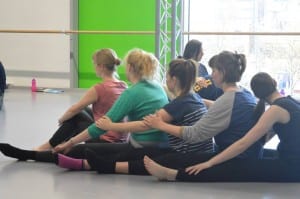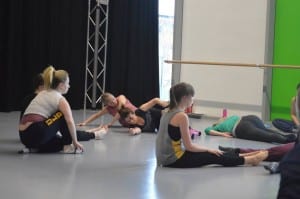Tuesday 25th March 2014
The Underscore is a framework which has been revised and developed since the 1990’s and we came into the space today knowing that our class is entirely based around this. Nancy Stark defines this framework as ‘…a score that guides dancers through a series of “changing states.”…’ (Smith, 2008, 90) Today as a class we worked with this process to create a piece of contact improvisation and developed it ourselves. This was our last class of the semester. It was time to bring every method of contact, every piece of experimentation and every last inch of fear together to explore one last time our questions of contact improvisation.
At first I felt a sense of loss unlike any other class, I couldn’t seem to find the ground, my feet or the sensation of movement that I needed to fully engage in the space. I broke this barrier of feeling lost when I first came into contact with another body. This helped me to feel like I was in the space and exploring it with another. Once this had happened I allowed my body to feel what it want and release all tension I held. At the beginning of the underscore I felt like I controlled what my body felt through pressure into the floor and guiding my body into a sense of feeling however as the class progressed and we approached the section ‘Overlapping kinespheres – the space through which their energy, movement, and attention are circulating.’ (Smith, 2008, 93) I let it choose its own pathways.
The question I aimed to answer after today class was ‘how do I continue with movement when my pathway has been interrupted?’ (Utting, 2014) Coincidentally this situation approached me and Emmie when we were giving and taking weight. Another dancer, Sinead, stepped into our joint kinesphere and started contact with us internally without physical contact. I initially thought oh no this now means I need to contact with Sinead, but I didn’t. It felt natural thanks to last weeks exploration of contact internally and through the eyes to carry on the movement pathway that me and Emmie were taking but now there were three of us on that journey of experimentation.
I feel that today I explored even further the idea of contacting with a part of my body which was not my hands. I explored rolling of people initiating from my head and lifting peoples weight with my elbows and knees using my core support for myself and the body I was contacting with. I found that this exploration helped me to feel more relaxed with the sensation of contact and the small dance I created seemed more playful rather than rigid movements strung together.
As soon as we finished the physical element of the underscore we moved onto harvest and reflection where without even thinking about what I was writing the words intense, unpredictable and influential appeared on paper. I took these as positive outcomes from our final class. Contact improvisation now reveals to me ‘The sense of freedom your body must have to fully engage in this practice with a further sense of awareness and spontaneity.’ (Utting, 2014) I feel like I have discovered ways to connect with other dancer’s centre of gravity and breath, in other words not only thinking about the physical connection between dancers but also the internal. Due to this I now believe is essential element which you must apply to contact improvisation to get the most out of it.
In reflection to my first blog of this module I asked myself the question what is contact improvisation to me? After 11 weeks I feel like there is no clear explanation, which is not a bad thing. Contact improvisation can be whatever you want it to be. It is an art form that can take you and your body in any direction. To me contact improvisation is an ongoing practice which will be constantly developing through exploration, experimentation and questioning of those who embrace it.
Works cited:
Utting, Z (2014) Contact Research Labs – structuring, investigating, performing and reflecting [seminar] Contact Improvisation: An Ongoing Research Lab DAN2005M, University of Lincoln, 25 March.
Koteen, D., and Smith, N. S. (2008). Caught falling: the confluence of contact improvisation, Nancy Stark Smith, and other moving ideas. Northampton: MA contact editions

